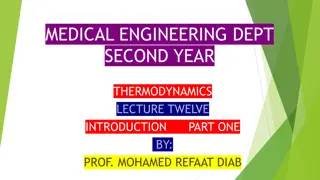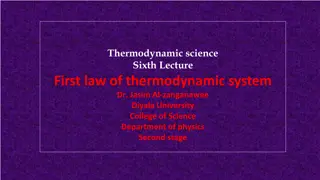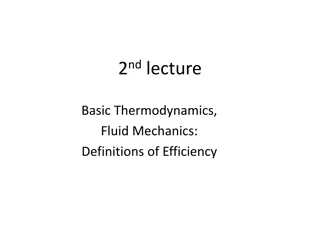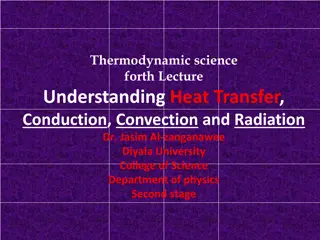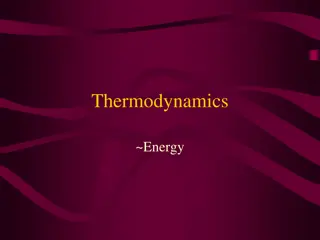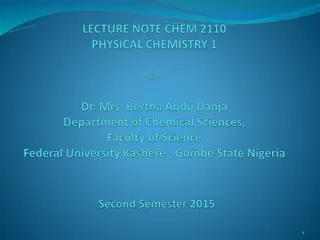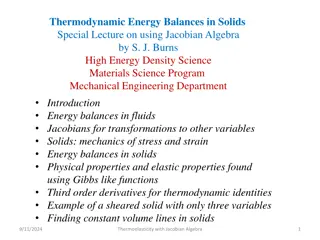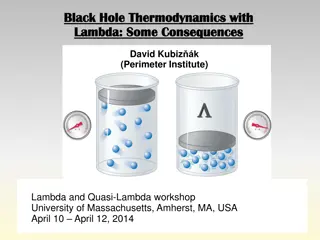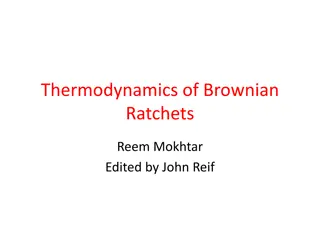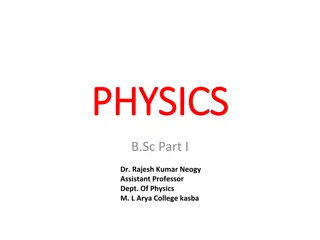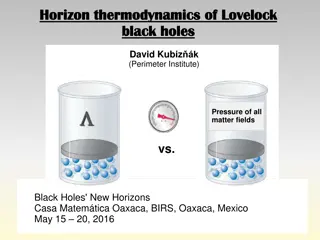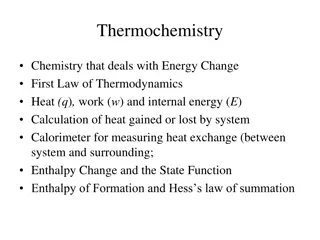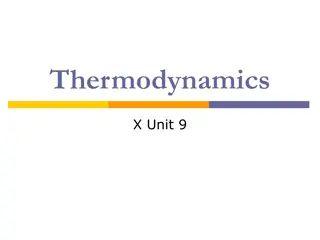Understanding Thermodynamics and Energy Transformation
Thermodynamics is a crucial unit that deals with how energy is transformed from one form to another efficiently. This field is essential for managing energy resources sustainably and covers topics such as temperature, heat, internal energy, and applications in various systems. Learn the basics of thermodynamics and its implications on everyday life.
Download Presentation

Please find below an Image/Link to download the presentation.
The content on the website is provided AS IS for your information and personal use only. It may not be sold, licensed, or shared on other websites without obtaining consent from the author. Download presentation by click this link. If you encounter any issues during the download, it is possible that the publisher has removed the file from their server.
E N D
Presentation Transcript
L 16 Thermodynamics-1 This unit deals with one of the most practical aspects of everyday life how we use energy We do not create energy, but transform it from one form into another These transformations should be done as efficiently as possible, since natural resources are limited These issues include science, but political and economic considerations as well 1
Energy use by source Existing energy sources must be used more efficiently New energy sources must be developed 3
THERMODYNAMICS The science dealing with heat, work and energy The study of heat energy and its transformation into mechanical energy. Is a set of a few basic empirical (based on observations) rules that place limits of how these transformations can occur, and how efficiently they can be carried out. 5
Some of the topics we will cover What is temperature? How is it measured? What is heat? What is internal energy? What is the difference between internal energy, temperature, and heat? Applications: engines, refrigerators, air conditioners, human body, electric power production systems, the atmosphere 6
Work and Heat produce same effect A drill bit gets very hot when drilling a hole metal in contact with a grinding wheel gets hot You can also get the bit or the metal hot by placing it in a torch Is there a difference in the outcome? the difference between work and heat must be made clear Grinding wheel 7
Engines Any device which uses heat to do work Steam engine, internal combustion engine Burn fuel boil water (steam) push piston (work) Hero s engine steam steam HEAT 8
Human engine The human body is an engine. Food in metabolism work out BODY ENGINE Energy out Energy in We are all subject to the laws of thermodynamics 9
Engine efficiency Energy in ($$$) Work out Engine Work out Efficiency = Energy in If we convert all of the energy taken in to work the efficiency would be 100% Are there limits on the efficiency? 10
Internal energy All systems have internal energy-- U The internal energy U is the sum of the energy of all the molecules in the system For example - in a gas the molecules are in random motion, each molecule has kinetic energy = m v2 If we add up all the kinetic energies of all the molecules we get the internal energy of the system: 1 2 1 2 1 2 = + + + + + 2 2 2 U mv m v m v etc etc 1 1 2 2 3 3 Box containing N molecules all moving around randomly U cannot be measured directly Is there a parameter that can be measured that represents U ? 11
Internal energy and temperature in a gas the molecules have energy because they are moving. the sum of all the energies of all the molecules is the system s internal energy the temperature of the system is a measure of the average kinetic energy of the atoms, Temperature Average Kinetic Energy 12
Temperature and Internal Energy Temperature, T, measures the average kinetic energy (KE) of the molecules The internal energy, U, is the total energy of all of the molecules T1 = T2 = T3 50 C U3 > U2 > U1 50 C 50 C 1 2 3 13
What is heat? System B at temp TB System A at temp TA Heat is the energy that flows from one system to another because of their temperature difference. Heat stops flowing when the two systems come to the same temperature. Heat was first thought to be an actual fluid (caloric), but it is not a fluid- it is energy! 14
Work can change internal energy When one object is rubbed against another, work is done and heat is produced When a gas is compressed its internal energy is increased; when it expands, its internal energy decreases The internal energy of a system can change if work is done on the system or heat is transferred to it. (1st Law of Thermo.) 15
How is temperature measured? We use the fact that the properties of materials change with temperature For example: oMetals expand with increasing temp oLength of liquid column expands (DEMO) oElectrical resistance changes oPressure of a gas increases with temperature oInfrared emission from objects changes color These devices will be discussed in the next lecture. 16
Length of a mercury column The length of the Hg column increases with temperature How is the thermometer calibrated? temperature scales Fahrenheit Celsius (centigrade) Kelvin Mercury column Mercury reservoir 17
Temperature scales: based on freezing and boiling points of water Celsius scale Fahrenheit scale boiling point 212 100 100 180 freezing point 32 0 18
Centigrade & Fahrenheit scales Scales are offset ( 0 F is not 0 C) Celsius scale is compressed compared to the Fahrenheit scale, 1 C 1 F 1 C = 180/100 = 9/5 F Conversion formulas: 5 9 9 5 = = T 32 T TF + 32 T C F C 19
Examples 1) What is the temperature in C if the temperature is 68 F? TC = (5/9) (TF 32 ) = (5/9) (68 32) = (5/9) (36) = 20 C 2) What is the temperature in F if the temperature is 10 C? TF = (9/5 TC) + 32 = (9/5 10) + 32 = 18 + 32 = 14 F 20
Absolute zero as cold as it gets! There is nothing particularly significant about 0 C or 0 F. Is there a temperature scale where 0 really is ZERO the lowest possible temperature? YES It is called the KELVIN scale. It doesn t get any colder than 0 K! At zero Kelvin, all molecular motion stops. We can see this from the behavior of gases, where pressure decreases with temperature. 21
Approaching absolute zero GAS A Gas Pressure GAS B GAS C C 273.15 C As a gas is cooled, its pressure decreases The P vs. T plot extrapolates to a temperature of - 273.15 C for all gases, this is absolute zero TK = TC + 273.15 TC + 273 One degree K = one degree C There are no negative Kelvin temperatures 22




